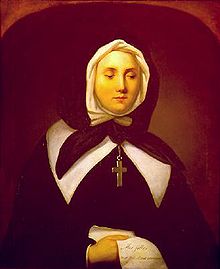Foundress of the Congregation of Notre Dame.
Marguerite Bourgeoys was born the sixth of twelve children of devout parents. After her mother died, Marguerite at 19 took care of her brothers and sisters. Her father, a candle maker, died when she was twenty-seven. A few years later, the governor of Montreal, Canada, Paul Chomedey de Maisonneuve was in France looking for teachers for the New World. He invited Marguerite to come to Montreal to teach school and religion classes. She accepted the offer.
Marguerite Bourgeoys gave away her share of the inheritance from her parents to other members of the family. In 1653, she sailed for New France. On arriving, she initiated the construction of the Notre-Dame-de-Bon-Secours Chapel in honour of Our Lady of Perpetual Help. She opened her first school in 1658 and she first worked with rich children, but soon started working with poor and rich people. She returned to France the next year to recruit more teachers, convincing four to accompany her. In 1670, she went to France again, and brought back six more women. Having braved dangerous travel and pioneer conditions, these women became the first Sisters of the Congregation of Notre Dame.
Bourgeoys and her sisters helped people in the colony survive when food was scarce, opened a vocational school, taught young people how to run a home and farm. Bourgeoys' congregation grew to 18 sisters, seven of them Canadian. They opened missions, and two sisters taught at the Native American school. Soon after, Bourgeoys received the first two Native American women into the congregation.
In 1693, Mother Marguerite handed over her congregation to her successor, Marie Barbier, the first Canadian to join the order. The congregation's religious rule was approved by the Church in 1698.
Marguerite spent her last few years praying and writing an autobiography. On December 31, 1699, as a young sister lay dying, Mother Marguerite asked God to take her life in exchange. By the next morning of January 1, 1700, the sister was completely well. But, Mother Marguerite had a raging fever, suffered 12 days, and died on January 12, 1700.[citation needed]
Legacy and Canonisation
Marguerite Bourgeoys was declared venerable in 1878, beatified on 12 November 1950, and canonised by John Paul II on 31 October 1982. She is commemorated in both the Catholic Church and in the Anglican Church of Canada on January 12.
She was buried in the sanctuary of Notre-Dame-de-Bon-Secours Chapel in Montreal. The church now includes a museum about her life and the early history of Montreal. A Quebec provincial electoral district in Montreal is named after Bourgeoys.


No comments:
Post a Comment
Please be respectful in your comments. Anonymous comments are no longer taken.